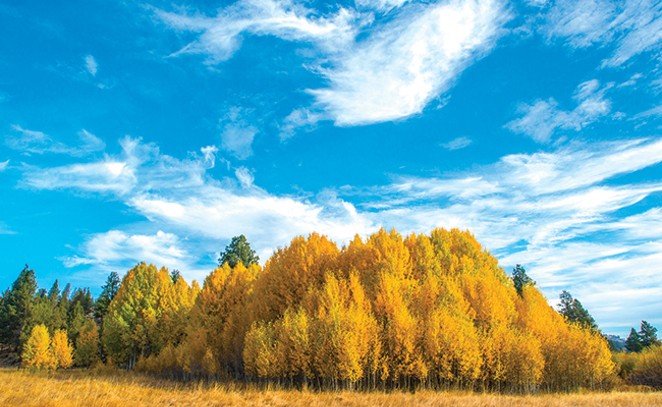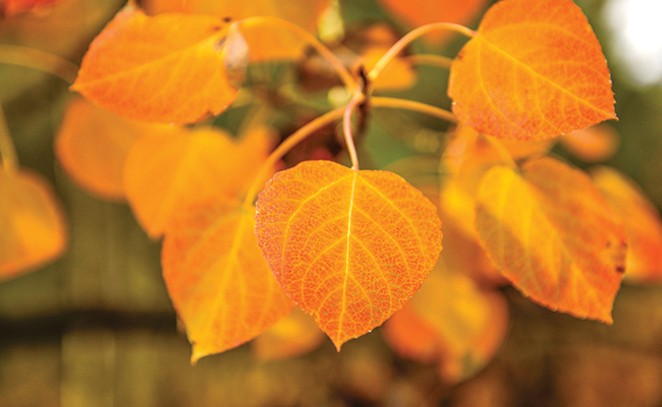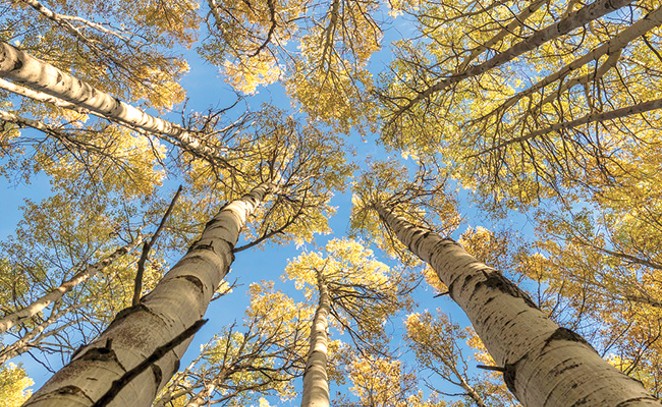Every fall the aspen trees of Central Oregon light up the forest with their brilliant changing colors. There's just something about their stark white bark, round yellow and orange leaves and delicate quaking sound that is so enchanting. But, did you know that aspens are more than your average tree? They provide year-round benefits to wildlife and people.

Quaking aspens (Populus tremuloides) are the most widely distributed trees in North America. Though they are more common in the Rocky Mountains and into Canada, eastern and Central Oregon are on the edge of their range. Here they are most often found in near rivers or creeks, along the edge of meadows, or in openings in the forest. Aspens can grow up to 40 feet tall with trunks as large as 10 inches. Individual trees will live for 100-150 years, but because they are clonal and reproduce via root sprouts the larger clone can be thousands of years old. Aspen groves from the same clone will even change color at the same time each fall!
Aspen and aspen stands are used by a wide range of wildlife and are considered biological hotspots—places rich in biological diversity. Their dense thickets provide cover and hiding spots for calving deer and elk. Woodpeckers use aspen trunks to create nesting cavities. Songbirds, bats, beaver, black bear and other wildlife nest and forage in aspen stands. In the winter, aspen stands provide warmer locations for wildlife to escape wind, snow and extreme cold.
Aspen trees also play an important role in our water cycle. Their dense shady stands collect and store snowpack longer than surrounding conifer stands. In the winter and spring, aspen slowly release their snowpack stored in these shady groves, adding cool water into our streams and groundwater. This is especially important for communities that rely on snowmelt for their water supply.
Aspen trees like disturbance and are good at colonizing a site after something like a fire moves through the forest. While the mature trees with their thin bark will often die in a fire, the roots below ground remain and will re-sprout in abundance. According to the U.S. Forest Service, as many as 50,000 to 100,000 can sprout on a single acre after a fire!
Today, aspens are very limited in their range in Oregon. It's estimated that 70% of the aspen woodlands in southeastern Oregon have been lost since the 1800s. So, what's causing the decline? Fire suppression and conifer growth, for one. Aspens evolved with fire and need frequent fires to reinvigorate their groves and stimulate the growth of new trees to replace the relatively shorter lived mature ones. Without fire, aspen stands tend to be overtaken by conifer trees, eventually blocking the light that sun-loving aspen need to thrive. Browse pressure can also make it hard for aspen stands to thrive. Those thousands of little suckers can only take so much munching from deer, elk and livestock. That's why you'll often see aspen stands around Oregon fenced in to give them a chance to get established.
Finally, climate change is one of the biggest threats to aspen. The ongoing intense drought and lack of precipitation in the West stresses these moisture-loving trees, making them more susceptible to insects and other diseases. That's why local land stewards like the Forest Service and Deschutes Land Trust are working to conserve and restore the aspen stands we have today, so they can thrive and hopefully adapt to a climate-changed future. Aspen restoration includes reintroducing fire where appropriate or removing encroaching conifers to let in more sunlight. Aspen caging or fencing also helps limit the intense browsing so young aspen can grow strong.
So, this fall when you are out and about enjoying the changing colors, be sure to take some time to appreciate all that aspens offer to the natural world. Their stunning yellows and oranges are only the tip of the iceberg!









